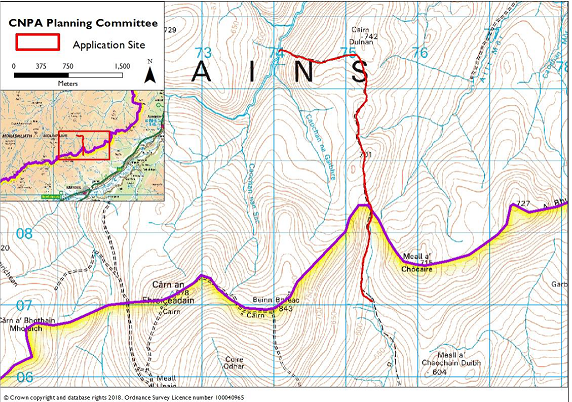
Last Friday the Cairngorm National Park Authority Board approved a “presumption against new hill tracks” in its new draft Local Development Plan which is about to be issued for consultation. This was welcome. Just a week later, those same Board Members, who all sit on the Planning Committee, were due to consider a report asking that a 5 km long new hill road across the Monadhliath be approved. Not a single objection had been lodged. Unbelievable you might think.
After a number of representations this week, officers will recommend to the Committee today that a decision be deferred to allow proper consultation. On the assumption that the officers’ recommendations will be accepted, this post does not look at the application itself – which involves 5km of track into a wild land area – only what has gone wrong with the planning process.
Failure to consult properly
The Balavil Estate described their Planning Application as “repair and improvement to existing hill road/private way” . This was wrong as there is no hill road at present linking the upper reaches of the Raitts Burn with the River Dulnain to the West. Nevertheless Highland Council advertised it as a “repair and improvement” and then CNPA staff replicated this when they advertised the application on their weekly planning list of 22nd October:
“CNPA ref: 2018/0400/DET Council ref: 18/03276/FUL Applicant: Balavil Estate Development location: Balavil House, Kingussie, Highland, PH21 1LU
Proposal: Repair and improvements to existing hill road/private way Application type: Detailed Planning Permission Call in decision: CALLED IN Call in reason: Application located within an upland area and sensitive landscape and therefore is considered to be of significance to the collective aims of the National Park.
Planning History: Recent planning history includes: • PRE/2017/0047 (17/05768/PREAPP)
The weekly lists then repeated this error under active planning applications as follows:
” Extract:22/10/18 2018/0400/DET Highland Council18/03276/FUL XXXXXXXXXX Repair and improvements to existing hill road/private way at Balavil House, Kingussie, Highland, PH21 1LU19/11/2018″.
No-one reading this, unless they knew the area very well, would have been aware that what was actually proposed was the construction of 5km of new road. The proof? None of the NGOs who monitor hill tracks had picked this up.
People only realised what was going on when the papers for this week’s Planning Committee were published at the end of last week. By then, under planning rules, it was too late to object. This week Dave Morris and I both wrote to CNPA planning staff asking them to withdraw the application to allow it to be advertised properly and consulted on. To their credit, after some deliberation, officers agreed to recommend to Committee that consideration of the application be deferred to allow consultation. By then the Strathy had sent its editorial to the printers (see above) and I had a full post drafted!
What “deferral” will involve remains to be seen. In my view the mistakes in Balavil’s application form will need to be corrected before the application can proceed further and the CNPA needs to then give people sufficient time to consider the application.
What’s gone wrong?
At one level its extraordinary that no-one at either Highland Council or the Cairngorms National Park Authority thought to challenge the Balavil Estate about how they had described their proposals and insist this be rectified. The reality, however, is that our Public Authority planning staff are, like other public sector workers, swamped with work and driven by performance reports to the Scottish Government about how quickly they process applications. Add to that many CNPA planning staff and Managers appear to have been involved in finalising the Local Development Plan. Add to that that much of the application was outwith the National Park boundary and the CNPA was processing it on behalf of Highland Council. And its possible to understand how a basic error which started outside the CNPA could have been compounded with the consequence that the whole legitimacy of the planning process was undermined. I am not saying this is the explanation, but it could be.
The positive thing, however, is that in the CNPAthere are checks and balances in place which means that errors like this can be rectified. In the Loch Lomond and Trossachs National Park Authority almost all decisions are delegated to officers. A similar failure there would never have been picked up because only a handful of planning applications are ever decided by Committee. The error here was detected precisely because a report had to be presented to Committee.
Once detected, officers were then prepared to engage about the concerns. In the LLTNPA staff are forbidden to engage with campaigners. Had the staff not listened, a number of people were ready to email ALL Board Members. In the LLTNPA its impossible to do this because Board Members don’t have Board emails.
Even if no-one had noticed the report in the Committee Papers, there would have been a good chance that Committee Members would have spotted the error and questioned the lack of consultation. The chances of that happening in the LLTNPA because Planning Committee Members are asked to consider only a tiny proportion of applications.
While I don’t condone what has gone wrong, we need to recognise that the democratic structures in the CNPA means that Balavil’s application for a new road in a Wild Land Area will now be subject to proper public scrutiny. For that the CNPA need to be applauded.
Next week I will take a look at what can go wrong when the Planning Committee are not involved, which is what happened at Balavil under the Prior Notification system in 2016.

Nick,
Please that you have given credit to the Cairngorms National Park Authority for their decision to postpone consideration of the track, however the original problems occurred.
Unbelievable!